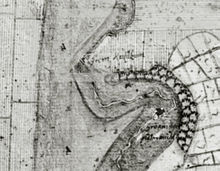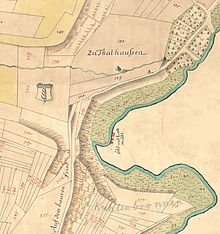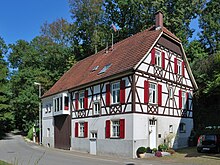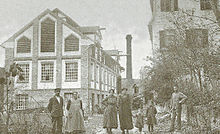Paper mill (Markgröningen)


The paper mill was previously a powder mill , then a water-powered paper manufacture and later a cardboard factory on the Glems above the Markgröninger district of Talhausen .
history
Starting difficulties
The paper mill was built in 1787 in place of the powder mill built in 1662 and later replaced by an “ Öhl and Lohmühl ” between the Kühlenbronn and Thalhausen channels . Since 1788, the paper miller Antonius Boden , who comes from Enzberg (Mühlacker) , has been producing hand-made paper from soaked rags that have been shredded using water power. Despite tax rebates, a rich dowry and a guarantee from his father-in-law Andreas Schell, the first paper man in Markgröningen was unable to refinance the necessary investments and immediately went bankrupt. This fate almost overtook his guarantor, who found it difficult to find a solid successor as a tenant, and sold the paper mill in 1801 for 2,800 guilders to the “paper manufacturer” Theodor Kober from Pfullingen . At the beginning of 1803 Jakob Dachtel acquired the business and half of a hemp grater located a little further upstream in the Gewann Kühlenbronnen for 4,000 guilders, in order to transfer it to his future son-in-law Immanuel Färber from Dettingen an der Erms .
Upswing and decline
Immanuel Faerber was the first Markgröninger papermaker to achieve economic production and to make the company one of the more important paper mills in Württemberg. He had two laid paper at his disposal and employed six workers who, in particular, produced fleece and printing paper. The Oberamtsbeschreibung from 1859 only lists two to three employees, although the operation at that time also included the Untere Lohmühle "initially" the paper mill and a hemp grater .
The cardboard factory burned down and rebuilt twice during the 19th century. After 1860, cardboard lids were made here on the basis of waste paper. After another fire in 1911, a new factory building was built and the medium-sized cellular wheel used until then was replaced by a Francis turbine . The factory had been owned by the Friederich family since 1897, who initially specialized in shoe soles and rear panels for radios. Most recently, it produced four to five tons of box and hard cardboard every day. The factory went bankrupt in 1967 and closed in 1969. In 1971 the factory building was demolished, the Mühlkanal filled in and the weir removed.
Relics
Today only the houses paper mills 1 and 3, which once belonged to the factory, are still standing. The paper mill 3 shown is a listed building. The door inscription of paper mill 1 indicates the former paper mill and its owners: Immanuel Faerber, C (atharina) Faeberin, 1811. Between the two houses there is a recessed floor slab that indicates the mill fire and the subsequent reconstruction. In the Glems there are still remnants of the weir at the former branch of the filled Mühlkanal.
See also
literature
- Petra Schad: Paper for Württemberg's residences . In: Müller, Mühlen, Wasserkraft . Volume 5 of the series Through the city glasses, history and stories about Markgröningen , ed. v. Working group on historical research, heritage and monument preservation in Markgröningen. Markgröningen 1995, pp. 148-161.
- Petra Schad: From rags to culture carriers. Manufacture and history of paper taking into account the Markgröninger paper mill. In: Ludwigsburger Geschichtsblätter , Heft 53 (1999), pp. 95-108.
- Thomas Schulz: Mill Atlas Baden-Württemberg , Bd. 3 The mills in the Ludwigsburg district . Verlag Manfred Hennecke, Remshalden-Buoch 1999, ISBN 3-927981-63-X .
- Information board on Glemsmühlenweg
Individual evidence
- ↑ The forest map for the Duchy of Württemberg drawn up by Andreas Kieser in 1682 is south (south is up). Source: Forest map 159 leo-bw.de / Photo archive of the Baden-Württemberg State Media Center .
- ↑ See Kiesersche forest map from 1682 and field map from 1752 ( landesarchiv-bw.de - N 1 No. 85 ) and Petra Schad: paper for Württemberg residences . In: Müller, Mühlen, Wasserkraft . Volume 5 of the series Through the city glasses, history and stories about Markgröningen , ed. v. Working group on historical research, heritage and monument preservation Markgröningen, Markgröningen 1995, p. 148.
- ↑ See Petra Schad: Paper for Württemberg Residences . In: Müller, Mühlen, Wasserkraft . Volume 5 of the series Through the city glasses, history and stories about Markgröningen , ed. v. Working group on historical research, heritage and monument preservation in Markgröningen. Markgröningen 1995, p. 150ff.
- ↑ Oberamtsbeschreibung Ludwigsburg (1859), chapter Markgröningen . Wikisource
Web links
- Map and information about the Glemsmühlenweg
- List of cultural monuments in Markgröningen (2011) (PDF; 33 kB)
Coordinates: 48 ° 54 '42 " N , 9 ° 3' 44.8" E



